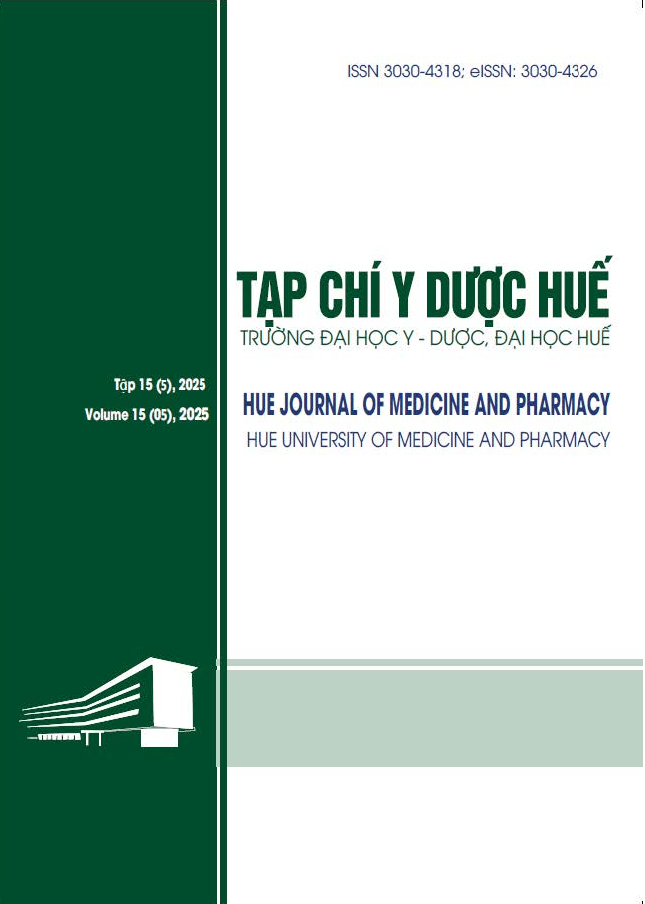Abstract
Background: Insomnia is a common problem in perimenopausal and menopausal women that affects health and quality of life.
Objectives: To determine the prevalence of poor sleep quality and related factors in perimenopausal and menopausal women.
Methods: A cross-sectional study was conducted on 104 perimenopausal and menopausal women from 10/2023 to 01/2024, based on the Pittsburgh Sleep Quality Index (PSQI).
Results: The prevalence of poor sleep quality (PSQI > 5) was 59.6%. Independent predictors of poor sleep quality included cohabitation with husband (aOR 0.10; 95% CI 0.02 - 0.43), passive smoking (aOR 5.33; 95% CI 1.66 - 17.15), caffeine use (aOR 4.42; 95% CI 1.51 - 12.93), and engaging in < 30 minutes of daily physical activity (aOR 0.11; 95% CI 0.03 - 0.37).
Conclusion: Poor sleep quality remains highly prevalent. Interventions to reduce passive smoking, limit caffeine intake, and promote regular physical activity are essential to improve sleep quality in this population.
| Published | 2025-09-30 | |
| Fulltext |
|
|
| Language |
|
|
| Issue | Vol. 15 No. 5 (2025) | |
| Section | Original Articles | |
| DOI | 10.34071/jmp.2025.5.24 | |
| Keywords | chất lượng giấc ngủ, PSQI, tiền mãn kinh, mãn kinh sleep quality, PSQI, perimenopause, menopause |

This work is licensed under a Creative Commons Attribution-NonCommercial-NoDerivatives 4.0 International License.
Copyright (c) 2025 Hue Journal of Medicine and Pharmacy
Roth T. Insomnia: definition, prevalence, etiology, and consequences. Journal of clinical sleep medicine : JCSM : official publication of the American Academy of Sleep Medicine. 2007;3(5 Suppl):S7-10.
Grandner MA, Jackson NJ, Pak VM, Gehrman PR. Sleep disturbance is associated with cardiovascular and metabolic disorders. Journal of sleep research. 2012;21(4):427-33.
Greendale GA, Lee NP, Arriola ER. The menopause. Lancet (London, England). 1999;353(9152):571-80.
Teoman N, Ozcan A, Acar B. The effect of exercise on physical fitness and quality of life in postmenopausal women. Maturitas. 2004;47(1):71-7.
Tô Minh Ngọc, Nguyễn Đỗ Nguyên, Phùng Khánh Lâm, Nguyễn Xuân Bích Huyên, Trần Thị Xuân Lan. Thang đo chất lượng giấc ngủ Pittsburgh phiên bản tiếng Việt. Tạp chí Y Học TP Hồ Chí Minh. 2014;6(S18):664-8.
Salari N, Hasheminezhad R, Hosseinian-Far A, Rasoulpoor S, Assefi M, Nankali S, et al. Global prevalence of sleep disorders during menopause: a meta-analysis. Sleep & breathing = Schlaf & Atmung. 2023;27(5):1883-97.
Nguyễn Thị Mỹ Châu, Diệp Từ Mỹ, Phạm Thị Thu Hiền. Chất lượng giấc ngủ kém và các yếu tố liên quan ở phụ nữ 50-60 tuổi tại thành phố Vũng Tàu, năm 2020. Tạp chí Y Học TP Hồ Chí Minh. 2021;2(25):168-74.
Nguyễn Đình Phương Thảo. Nghiên cứu các rối loạn chức năng ở phụ nữ mãn kinh tại thành phố Huế và hiệu quả của một số biện pháp điều trị, Luận án Tiến sĩ Y học. TP Huế: Trường Đại học Y - Dược, Đại học Huế; 2017.
Backhaus J, Junghanns K, Broocks A, Riemann D, Hohagen F. Test-retest reliability and validity of the Pittsburgh Sleep Quality Index in primary insomnia. Journal of psychosomatic research. 2002;53(3):737-40.
Phạm Lê Thị Thanh Trúc, Huỳnh Ngọc Vân Anh. Trầm cảm, chất lượng giấc ngủ và các yếu tố liên quan ở phụ nữ tuổi mãn kinh tại xã Phước Hòa, huyện Tuy Phước, tỉnh Bình Định. Tạp chí Y Học TP Hồ Chí Minh. 2019;5(23):252-9.
Kim MJ, Yim G, Park HY. Vasomotor and physical menopausal symptoms are associated with sleep quality. PloS one. 2018;13(2):e0192934.
Wang X, Wang L, Di J, Zhang X, Zhao G. Prevalence and risk factors for menopausal symptoms in middle-aged Chinese women: a community-based cross-sectional study. Menopause (New York, NY). 2021;28(11):1271-8.
Ahmady F, Niknami M, Khalesi ZB. Quality of sleep in women with menopause and its related factors. Sleep science (Sao Paulo, Brazil). 2022;15(Spec 1):209-14.






